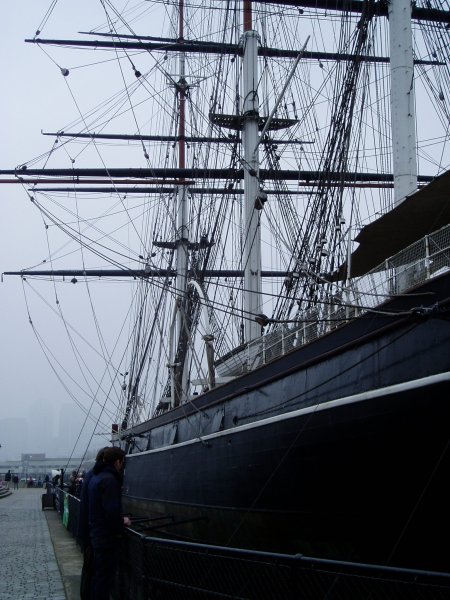Greenwich
Jump to page 1 2 3 4 5 6 7 8
Greenwich, for many years one of England's main ports, lies just east of London on the Thames. It's a 45 minute boatride from central London, or a 15 minute ride on the underground.
 This building in in Greenwich was once a royal palace, then a maritime school for the British Navy. Now it's part of a university, and houses a music school. We heard opera music coming from the windows.
 The Cutty Sark was one of England's fastest tea clippers. Each year the clippers would sail to the far east for the tea harvest. Once the harvest came in they would load the ships as fast as they could, and race back to England. The first ship to Greenwich would get the best price for the tea it carried. The Cutty Sark, at dry dock in Greenwich, is the only surviving British clipper.
 The Cutty Sark fully rigged.
 I share a moment at ease with Capt. James Cook, who explored the Atlantic and Pacific, and once made land at Newport, Oregon.
 (Warning, Lecture)
Okay, so, in 1707 a navigational faux pas caused a good portion of the British Naval Fleet to run aground, killing more than 2000 men, and prompting calls for a better system of navigation. The biggest part of the problem was that there was no reliable means of judging a ship's longitude.
The Royal Observatory had already been founded in Greenwhich to help solve the problem, and then, in 1714, Parliament established a board of experts, and promised £20,000 to the developer of a system for finding a ship's longitude at sea. Latitude was no problem, all you needed to do was locate sun (or a known star) and the horizon, and compare their relative positions against a chart. To measure Longitude, a sea captain needed to know the exact time at his current location, compared against the exact time at a fixed point.
Most people thought this would be accomplished by reading the heavens, but no one had a good way to do it. (Someone eventually figured out how, but the calculations took about 5 hours, by which time the ship had gone a long way). John Harrison, a carpenter from the countryside, decided a sea clock was the answer. He figured a captain could use the sun to determine the time at his current location, and compare that against a very accurate clock set to the time at his home port. Over something like 40 years Harrison built four different prototypes. His fourth clock, H4, resembling a large pocketwatch finally did the trick, with the right combination of design and materials to keep nearly perfect time at any temperature and humidity, unaffected by the rolling of the ship. Captians quickly took to Harrison's clock, but the board of experts, biased against mechanical devices, didn't give Harrison the award until he was in his 80's.
Later on, the 7th Royal Astronomer, Sir George Biddell Airy, built a telescope on a fixed axis, directly north to south, from which he could observe one precice slice of the sky each night. His goal was to create the most accurate map of the night sky ever. He made observations every night for years and years, but his methods were a little sloppy, and his map didn't end up rocking the world. His telescope did, though. When the crown looked to standardize the point from which longitude would be measured, the Prime Meridian, it chose the line passing directly through the cross-hairs of Biddell Airy's telescope. Eventually the Greenwich meridian became the world standard.
Also at the Greenwich Observatory is a time ball that for years would drop at precisely 1:00 p.m. Ship captains on the Thames would watch for the ball to drop, and set their clocks accordingly.
The building pictured above houses the Biddell Airy telescope. The roof and door open when the telescope is in use. Harrison's clocks, including the famous H4, are on display in the attached museum, and now you know why that's cool.
Next Page (No more lectures, I promise).
|





















